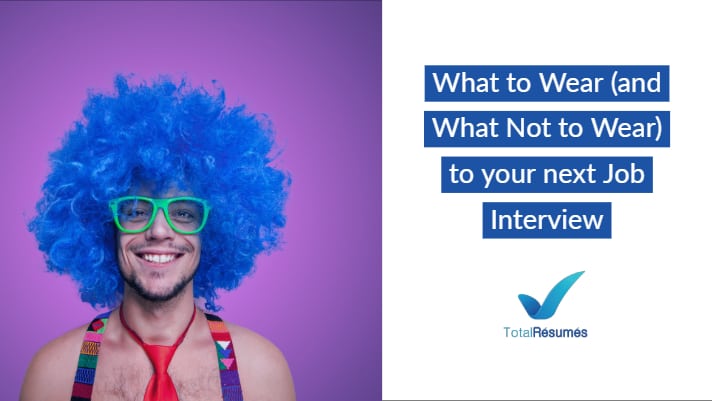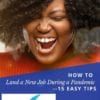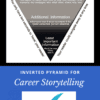
The job search has changed over the past 10 years. So have fashion trends. But one thing that hasn’t changed in the job search process is that people will judge you based on first impressions.
What you wear to an interview may have changed — in some situations — but the need to dress appropriately for the interview has not.
It used to be that a suit (for men) and a dress (for women) was required attire for a job interview. Now, wearing a suit might actually work against you — for example, it might signal to a prospective employer that you don’t understand the company culture. (Particularly if the employee dress code leans more towards jeans and sneakers than ties and loafers.)
While it’s important to feel comfortable in what you wear to an interview, you don’t want to look too comfortable. Little details about your attire will likely be noted by the interviewer and can make the difference between getting a second interview (or job offer) or not.
Dressing appropriately for an interview demonstrates that you’ve done your research and that you pay attention to detail. Just like you would study the company’s website ahead of time to be prepared for a job interview, studying the company culture — especially as it relates to employee attire — demonstrates your interest in working for the company.
You’ve heard the old saying, “Dress for success.” Nowhere is that more relevant than in a job interview.
Don’t give the HR person or hiring manager a reason to rule you out because you were overdressed, underdressed, or sloppily dressed.
The hiring manager can form an impression about you in the first five seconds of meeting you. Dressing appropriately conveys a very different impression than an impression made with poorly hemmed pants and shoes that are falling apart.
It’s very difficult to change a first impression.
Even if your interview is a virtual interview (telephone or video — i.e., Skype), you should still “dress to impress.” Don’t make the mistake of only dressing your top half for a video interview either. There are dozens of horror stories about having to stand up suddenly or change positions and your suit-on-top-shorts-on-the-bottom look is revealed.
Dressing appropriately can also give your confidence a boost. Getting a compliment about your appearance from friends or family before an interview can put a smile on your face and a spring in your step. On the other hand, if you are worried about a loose sole on your shoe, it can distract you.
The right attire can also affect how credible you are perceived to be.
The Lab Coat Effect
You’ve been told “not to judge a book by its cover,” but the reality is that we constantly judge things by their appearances. It’s why “curb appeal” is so important in real estate.
Clothes can make an impression — for better or worse. But more important, the right clothes can convey authority. Clothing not only communicates to others how you want to want to appear, but may also impact the way you think about yourself.
These concepts were reinforced by a research study.
In a study conducted by the Kellogg School of Medicine, researchers found students did better on tests that measured accuracy and attention span when they wore a white lab coat. The lab coat — long associated with scientists and medical doctors — apparently leads students to aspire to live up to it. Students wearing lab coats performed better in concentration tests and were more engaged in the activity.
While no one is suggesting you wear a white lab coat to a job interview (especially if you’re not in the medical or scientific field!), this research validates the need to wear appropriate clothing to both make you feel more confident and reinforce the confidence of the interviewer that you are the right candidate for the position.
Interviewing When You’re Currently Employed
If you are job hunting while you are currently employed, you might find yourself wondering what to do if you have a job interview scheduled for a day you have to work. How do you dress for an interview when the interview attire is significantly different from what you wear to work in your existing job? You don’t want to show up for work in a suit when you normally come to work dressed in khaki pants and a button-up shirt.
Instead, plan to change clothes before your interview — but don’t change at your current workplace or at the company where you are interviewing. Instead, change somewhere in between — preferably someplace that you will have access to a full-length mirror so you can double-check every detail of your appearance. If you don’t have time to go home, a mall or clothing store can be options. Be sure to allow yourself plenty of time to change and still get to the interview a few minutes early.
And don’t forget to change back into your regular work clothes before you go back to the office. For this reason, you may want to schedule your job interview towards the end of the workday so you don’t have to change clothes again. (This is a good idea anyway so you don’t feel rushed in the job interview.)
How to Research a Company’s Dress Code
To prepare for the job interview, research the company. The same is true when deciding what to wear to the job interview. There are three ways to figure out a company’s dress code.
- Ask someone who works there. If you already know someone who works for the company, reach out and ask. If you’re not sure if you’re already connected to a current employee, do a search on LinkedIn or type the company name in the search bar on Facebook. On Facebook, look at who “Likes” the page and click on the profile to see their employer information, if they provided it. On LinkedIn, type in the company name in the search box and it will show you your connections — and shared connections — who are currently or previously affiliated with the company. You can also reach out to the hiring manager and ask about appropriate interview attire.
- Conduct a visual inspection. If you don’t have an inside source — and don’t want to ask the hiring manager directly — go see for yourself! If you arrive at the beginning or end of the workday (or around lunchtime), you should be able to get an idea of dress code by seeing what people are wearing as they enter or exit the building. Be careful, however, if you use this method, as some companies have events like “Casual Fridays” that may throw off your investigation.
- Snoop on social media. If your prospective employer has social media accounts, browse the photo gallery for photos showing people at work. However, make sure you’re viewing an actual photo from the company, and not a stock (purchased) photo. And, as with the “Casual Friday” caution above, make sure the photo is representative of a “day in the life” of the company employee, and not a special event.
Once you have a general idea of dress code, you need to decide how to apply that information to what you’re actually going to wear. One guideline for interview attire is to “Dress One Step Higher.” Once you know what an employee in the position you’re applying for would normally wear to work, elevate it one notch. So, for example, if the typical employee wears khaki pants and a button-up shirt, you might wear dress slacks, a blazer, and a shirt with a tie. Wearing a suit to a company with a less formal dress code would look out of place. This type of attire is usually referred to as “business casual.”
Business casual attire is appropriate for interviews where a full suit would be overkill. For men, choose a dark, single color or lightly patterned sports coat or blazer, solid color dress slacks or trousers, a collared shirt, complementary tie, and dark-colored dress shoes. Socks should closely match the trouser color. Although the word “casual” is in the description, khaki pants are too casual. For women, a pair of black dress slacks can be worn with a nice sweater and/or button-up shirt or blouse, or button-up shirt and blazer or jacket, and dress shoes or low-heeled shoes. A modest dress (knee length or longer in an interesting color or a muted pattern) is also an option.
When interviewing for a job in retail, food service, or customer service, the right interview attire might lean more towards “casual” than “business casual.” In this situation, you’re not wearing a jacket or necktie, but the outfit still has to look professional. A collared shirt (with no tie) or polo shirt and slacks or neat khaki pants are appropriate. Men can wear a jacket or blazer but can take it off if it seems too formal. For women, a dark blazer with a simple blouse or button-up shirt can be worn with khaki pants or even dark-wash jeans if they are well fit, with no rips or tears. Shoes should always be closed-toed — no sandals or flip-flops.
If you’re interviewing for a job that requires you to wear a business suit every day, however, that’s how you’d dress for the job interview. This attire is appropriate for most executive roles as well as positions in law, banking, and finance. In this case, men would wear a conservative suit with a white or solid color shirt, tie, dress socks, and well-shined shoes. Women would wear a suit (either a pantsuit or skirt suit) or a conservative dress with panty hose and dress shoes. You can offset a black or dark suit with a pop of color in the form of a brightly colored shirt or blouse. However, it goes almost without saying that women should avoid short dresses and low-cut, revealing necklines when choosing interview attire.
For both men and women, avoid anything too bright or flashy. Don’t let your clothes be a distraction. You want the focus to be on you, not what you’re wearing. Be remembered for your interview answers, not your interview attire.
Do’s and Don’ts of Job Interview Attire
Do take it easy on perfume and cologne (or skip it altogether). You never know when someone might be allergic.
Do pay attention to your shoes — because your interviewer will! (Pay special attention to heels and soles.)
Do dial down the accessories — avoid flashy jewelry and large sunglasses. Women, only wear one ring per hand. If you have a lot of piercings or earrings, take out all but one of them so they aren’t a distraction.
Do your best to cover any tattoos.
Do focus on fit. Items that are too big or too small or too loose or too tight will have you focusing on what you’re wearing, not what you’re talking about with the interviewer. Try out an outfit before you wear it to a job interview. Make sure it’s comfortable to sit in as well as stand and walk in.
Don’t get too crazy with colors or patterns.
Don’t wear socks that are too short with your pants. Socks should cover at least half the leg so that when you sit down, no leg shows.
Don’t forget your hair! Your hairstyle should be professional and shouldn’t distract the interviewer.
The Six Biggest Mistakes in Dressing for Interviews
Men:
- Dirty and wrinkled clothing that doesn’t fit properly
- A shirt that is too tight at the collar or around the waist
- Dirty hands, nails, or hair
- Dirty shoes, or shoes that don’t match the outfit
- Wrong style clothes
- Piercings, noticeable tattoos, inappropriate hair color
Women:
- Too much or inappropriate jewelry
- Too much/too little makeup
- Scuffed or inappropriate shoes
- Clothing that is inappropriate for the workplace
- Ill-fitting clothing
- Piercings, noticeable tattoos, inappropriate hair color

